BRUSHING YOUR PET AT HOME
Dogs
Brushing is an integral part of caring for your canine, whether your dog has short, long, curly or wiry fur.
At home, grooming is an important step to keeping the fur healthy, shiny and clean. By brushing your canine regularly, it removes dirt, excess dander and helps to move natural oils through the coat aiding in moisture distribution.
It is also a strong bonding tool between your canine and you as it often mimics the grooming that the dogs’ mother did when your four legged family member was just a puppy.
Grooming your dog at home doesn’t have to entail a full groom complete with clippers, styling or even bathing. There are different facets of grooming that you can do at home, and is encouraged by most groomers, for in between appointments.
Groomers cannot give your dog a full, efficient, luxurious coat of fur performing two- three grooms a year. It must be a joint effort between groomer and owner.
However, if you believe that the only grooming your four legged family member deserves is getting shaved down to the pink once a year, Be prepared for a higher price, sensitive skin with high probability of sores under the coat and possibly having to switch groomers often.
Lack of brushing can cause severe matting, which results in the dog being shaved naked and you may have to put him in a t-shirt so he doesn’t get sunburned.
Understanding Fur
The easiest way to understand fur, we’ll use a dog as an example, is to think of your dog as a house.
The siding of a house repels water, wind, snow, dirt and other elements. By repelling the elements, it enables the underneath insulation to stay dry and clean so it can maintain a top performance level.
The dogs’ top coat (the hair furthest away from the skin), is often coarse and wiry. It acts the same as siding. It sheds water, wind, dirt, snow and protects the dogs’ body from the elements, keeping the fur close to the skin clean and dry.
Insulation of a house prevents heat from escaping in the cold and heat from going in when it’s hot.
The undercoat (fur next to the skin), is usually soft, fluffy and a lighter color. It does the same as insulation, keeps the dog either warm or cool.
Now, if the insulation of a house is clumpy or not uniform in thickness (similar to using sawdust for insulation) the house is riddled with hot and cold spots.
If the undercoat on a dog is clumpy, guess what, that dog will get cold spots and hot spots. He won’t have a uniform skin temperature which will result in fluctuating body temperature.
Vapour barrier in a house allows moisture to leave the house while preventing moisture from entering. In essence the house is able to breathe.
The skin of a dog is much the same. It allows moisture out of the body in the form of sweat, but prevents water from entering into the body through the skin.
When the coat is properly brushed out, the skin can breathe properly and the coat is very efficient, just like a well-built house.
However, if the fur is allowed to get matted or dead fur is not removed, the sweat from the skin won’t be able to escape. Unfortunately, the skin is not a plastic vapour barrier used in houses and can rot if kept moist too long. The constant moisture builds up on the skin, resulting in hot spots which can develop into open sores.
To keep the dogs’ body temperature uniform and healthy, the fur must be groomed on a regular basis to de-tangle any knots and remove any shedding coat. A healthy coat is an efficient coat, which will keep the dog happy, healthy, warm in the cold, cool in the heat and dry in the wet.
Just like your house.
When To Start Brushing
The most opportune time to start, is as soon as the dog gets settled into your household as a puppy. But sometimes this is unrealistic, especially if you have a rescued dog residing with you.
The worst time to decide that you are going to start de-tangling Fido is when he is already matted or two days before a grooming appointment.
Brushing on a regular basis is exactly what it says. Once a week is preferable, more if you have a long haired mutt that easily matts.
Different Strokes For Different Coats
The breed or mixture of breeds of your four legged wonder will dictate the texture and type of fur he will be carrying on his body. Because of the variety of mixes, and the variety of coat types within a particular breed of dog, it is easier to learn coat types rather than breed specific coat types. You will have to judge by yourself exactly what type of coat your dog has.
If you are uncertain, you should always check with a professional groomer that can see and feel your dogs’ fur.
Smooth coat: Short coat lays close to the skin. These dogs tend to be constant shedders, but will shed more in the spring and fall. A furminator or similar deshedding tool works the best on these canines. If your dog likes the vacuum, this is a great way to suck up unwanted hair.
Double coat: A coarse outer coat laying over top a soft light colored undercoat. Shedding typically takes place twice a year in the spring and fall, although double coated breeds living in the house tend to shed small amounts all year around. Pin brushes and combs are the choice tools for this breed.
Silky coat: The fur is silky and smooth. When kept in a long style, they look regal; however, they are hard to maintain in a long style and need to be brushed every day at least once. The fur is very silky and will matt extremely easy. A slicker brush and a comb will work the best on these pups.
Coarse, wiry coat: This is the texture most terriers sport. Their coat is very wiry, but they also have a soft undercoat. If the fur is left too long between brushing sessions, it will matt tightly, especially on the legs, chest and stomach. Slicker brushes and combs work well with this style of coat.
Soft, curly coat: Often cited as a non-shedding breed, poodles and bichons fall into this category. They shed, but the fur gets trapped in the curls. It is imperative to brush this coat type regularly, once a day when the coat is longer, especially before a bath. Slicker brush and comb are must haves for these dogs.
Many mutts won’t fall neatly into any of the above categories and often will have a combination of two or more categories.
Before you buy every brush on the shelf, let a professional groomer investigate your pets’ fur and recommend the proper tools.
Which Brush Is Which?
Pin brush: Wire or plastic teeth. Wire is preferably as plastic teeth often cause static to make the fur fly away and full of static.
Slicker: pets with sensitive skin should always have a slicker rated soft or extra soft. Burns can easily happen with a slicker if you are too aggressive next to the skin. The teeth can create tiny scratches on the skin that are naked to the eye, to produce red irritated skin. Always brush away from the skin.
Soft bristle: thin bristles, usually plastic, clumped together. Good to use on dogs or cats recently shaved and short haired dogs to pick up loose hairs. Also a good for puppies and kittens. A soft shoe polish brush works great.
Comb: A metal comb is the best. Many combs come divided with the teeth spread further on one half and closer on the other half. The closer the teeth, the better for catching clumps and matts.
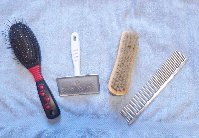
From left to right: Pin brush, Slicker brush. Bristle brush, Comb De shedding rake: Great for removing shedding fur easily, painlessly and quickly. Works for any shedding dog that isn’t matted.
Deshedder or carding tool: These are great tools for deshedding. The most well-known one is the Furminator. The trick with this tool is to get the angle correct. If the tool is making a sound on the hair that sounds like broken static from a radio, you have the angle wrong and the tool is simply shredding the hair. Adjust the angle so you have a smooth sound and watch the fur come out.
Dematter:This tool can be very dangerous as the blades are very sharp, meant to cut through a matt. It is easy to cut your pet or yourself with this tool. Not recommended for pet owners without professional instruction.
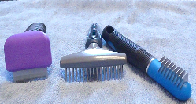
From left to right: Deshedder, Shedding Rake, Dematter
Proper Brushing
Picture your dog as being divided into three parts, Front part: everything from the shoulders forward, Middle: the rib cage, Rear: the hips, butt and tail.
Work one part of the dog thoroughly before moving to the next part. By working in this way, it lessens the chance of missing any part of the dog. Pay particular attention to the flank area (behind the ribs) and the back legs.
Lift a section of fur and hold it with your hand.
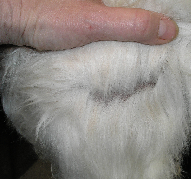
Using the proper tool (a slicker is pictured), brush a thin layer of fur.
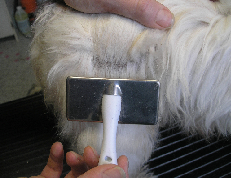
If there are no snags, pull down another thin layer from under your hand holding the fur up.
Continue in this manner until all sections are smooth and de-tangled.
Always brush with the lay of the fur.
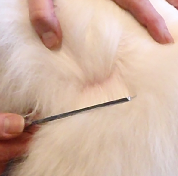
Do it all over again with a comb. The brush straightens out the bulk of the fur, bigger tangles and loosens any coat ready to come out.
The comb eases out any coat missed and detangles any smaller tangles.
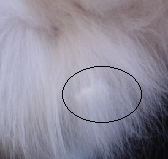
Before bathing, you should be able to get a fine toothed comb through the coat without any snagging. If the comb snags, stop, lift the fur and work out the section with the snag as described above.
If you get a number of teeny tangles that are stuck in the fur and the comb misses them, take a slicker and run it through the section with the small tangles.
The slicker will usually catch them.
If that doesn’t work, just pull them out with your fingers. They must be removed before a bath as they will tangle and create matting.
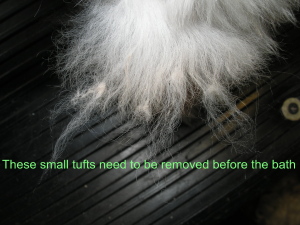
Matts
Learn why and how matts form. If Rover has some light matting, don’t worry, small infrequent matts can easily be combed out using either a comb or dematter.
Starting at the end of the matt, pick through the matt with the comb gradually working your way closer to the skin. Use the same method if using a dematter, but be careful with the dematter as the blades can easily cut you or the dog.
If you are lucky enough to have a pair of thinning shears (scissors with one straight edge and one edge of teeth), Simply cut through the matt in two or three different places, then comb the matt as stated above.
Cornstarch is also useful when trying to eliminate matts. Take a pinch of cornstarch and rub it into the matt. Let it sit for a few minutes, then gently brush it out. the cornstarch loosens the matt, making it easier to comb or brush it out.
if you are insistent on cutting out a matt, which is not recommended, however because I know, and you know, that at some point you may get the itchy feeling to just eliminate the matt the easiest way possible, here is the safest way to cut out a matt.
If the matt is tight against the skin, cutting the matt may not be possible. You run the risk of cutting not only hair, but your pooch as well.
Slip the comb between the matt and skin, using the comb as a guide, scissor the matt off. By slipping the comb between the matt and skin, you have created a safety barrier to prevent any cuts.
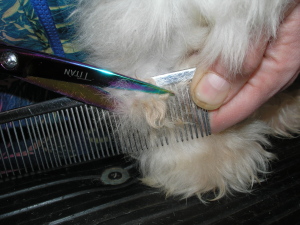
Now take that comb and thoroughly comb out where you have cut.
If you have a thick big matt, with the comb as a barrier, cut through the matt and work the remainder of the tangled fur out with the comb.
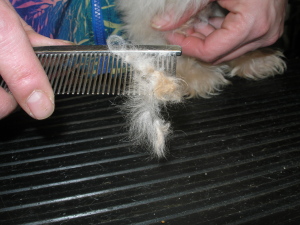
If your dog is matted from nose to tail, please, take in, shave it and start from the beginning.
Cats
Your cat may only let you brush it for a couple of minutes at time. Great! There are no rules that state you have to pin your cat down to groom it for hours. So what if you are only able to run the brush over her twice. If you can do it a few times throughout the day, that’s good. The more you do it, the longer you will be able to it.
Again the best time to start brushing slasher is when she is a kitten. However, if you have had to get your cat shaved, you can start a few days after the shave.
The best tool to start with after a shave should have soft bristles. I suggest getting a soft shoe polish brush to use until the fur is at least one inch long.
Then you can switch to a slicker or deshedder.
If you are putting too much pressure on the slicker or deshedder, the cat will let you know either by walking away or drawing blood.
Medium and Long haired cats are groomed as described for the dogs. The slicker works the best.
Short haired felines use a slicker and a deshedder. If you are too aggressive with a deshedding tool, you might create bald spots, so be careful.
Do Not Cut Matts On Cats!
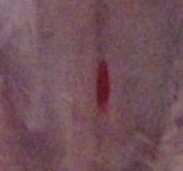
Cats have very thin skin that often gets pulled up into a matt. You may think you are cutting hair and blood starts gushing when you cut the flap of skin.
The safest way to cut a matt on a cat is don’t do it.
